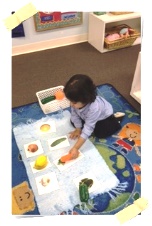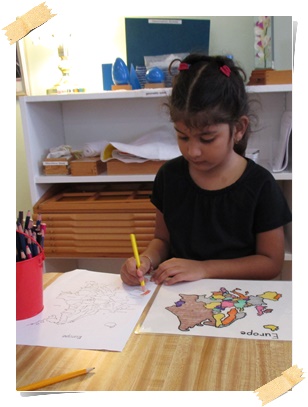Montessori Curriculum
Our classrooms are child-centered environments, carefully prepared with attractive, durable and developmentally appropriate hands-on lessons. Children are busy with self-chosen work and progress at their own pace. They enjoy individual as well as small group and large group activities. Using “inside voices”, the children are allowed to converse with one another while they are working, increasing their verbal, vocabulary & social skills. The classroom areas are:
PRACTICAL LIFE:
This area includes lessons in dry or water pouring, sponging, spooning, buttoning, tying, buckling, sweeping, food preparation, polishing silver, dusting, etc. The lessons allow the children to become independent in taking care of themselves and increase the awareness of their environment, concern for its upkeep and skills to maintain it. The lessons improve eye-hand coordination and fine motor skills, and are an indirect preparation for reading and writing as they are taught to go from left to right. They learn careful and controlled movement as they practice pouring without spilling. Practical life lessons range from very simple activities for the younger children to more difficult and lengthy challenges as they get older and more adept.
SENSORIAL
The sensorial lessons are designed to isolate one attribute (color, length, height, shape, etc.) The children match like objects or sequence by size, find and correct their own errors, and learn the correct vocabulary.
LANGUAGE
The language program is phonics based – we teach both letter names and letter sounds but the letter sound is emphasized. The children work with lessons that help them identify beginning, middle and ending sounds. They learn opposites, rhyming and patterning. We have word building lessons that lead towards learning to sound out words. Once they are able to read words, they progress to phrases and sentences and eventually they practice with emergent literacy books. We strive to increase the children’s appreciation of the importance and beauty of language as we expose them to a variety of literature and poetry. Specific vocabulary is taught (“rose” or “carnation” instead of “flower”). Various lessons are available to strengthen the finger muscles and the pincer grip to prepare for the use of the pencil. When they are ready, they learn and practice handwriting. Verbal expression is encouraged. The children first dictate
ART & MUSIC:
Various art mediums are available throughout the school year. The art area includes an easel, water colors, play dough, materials for making a collage as well as crayons, markers and pencils for drawing. The children are encouraged to be creative and not just reproduce the model. When the class gathers as a group, music is a popular activity; they learn traditional children’s songs, rhythm band instruments, music and movement and listen to classical music or music from around the world. The older children learn art and music appreciation.
MATH:
Math concepts are made fun and simple, using manipulatives that start off with a very concrete experience that leads to abstraction. The children first learn to count quantity, then the numeric symbols, and finally they combine quantity and symbol. We start with 0-9 then progress to the teens and the tens. They learn number recognition and number sequencing up to and beyond 100. They build big numbers with the “golden beads” that teach the decimal system. The concepts of addition, subtraction, multiplication and division are taught, again using hands-on manipulatives. Once the concepts are understood, the math facts are practiced with a variety of lessons. The older children learn money, time and measurement.
PHYSICAL & EMOTIONAL :
Gross and fine motor skills are developed using all the various, developmentally appropriate apparatus. The outside playground is used daily, or several times during the day for the children that stay for aftercare. “Coach Joe” visits to teach sports and sportsmanship. Social skills are learned by the day to day interaction the children enjoy amongst themselves and with their teachers. Good manners are expected. Peaceful conflict resolution is taught as the children are encouraged to resolve their own differences with adult intervention as needed. Independence, self-discipline and self-confidence develop as the children learn the skills required to take care of their own needs and help others. Peer teaching is encouraged.
SCIENCE & CULTURE:
There are numerous science lessons in the classrooms: rocks for matching, parts of animals and plants, magnetic vs. non-magnetic, the solar system, sink and float, life cycles, and food groups to name a few. The geography area includes flags from around the world, a continent puzzle map and puzzle maps of each continent and the United States. Pictures of places and people from around the world are available for viewing, and the “continent of the week” allows for more in depth study of each continent.

